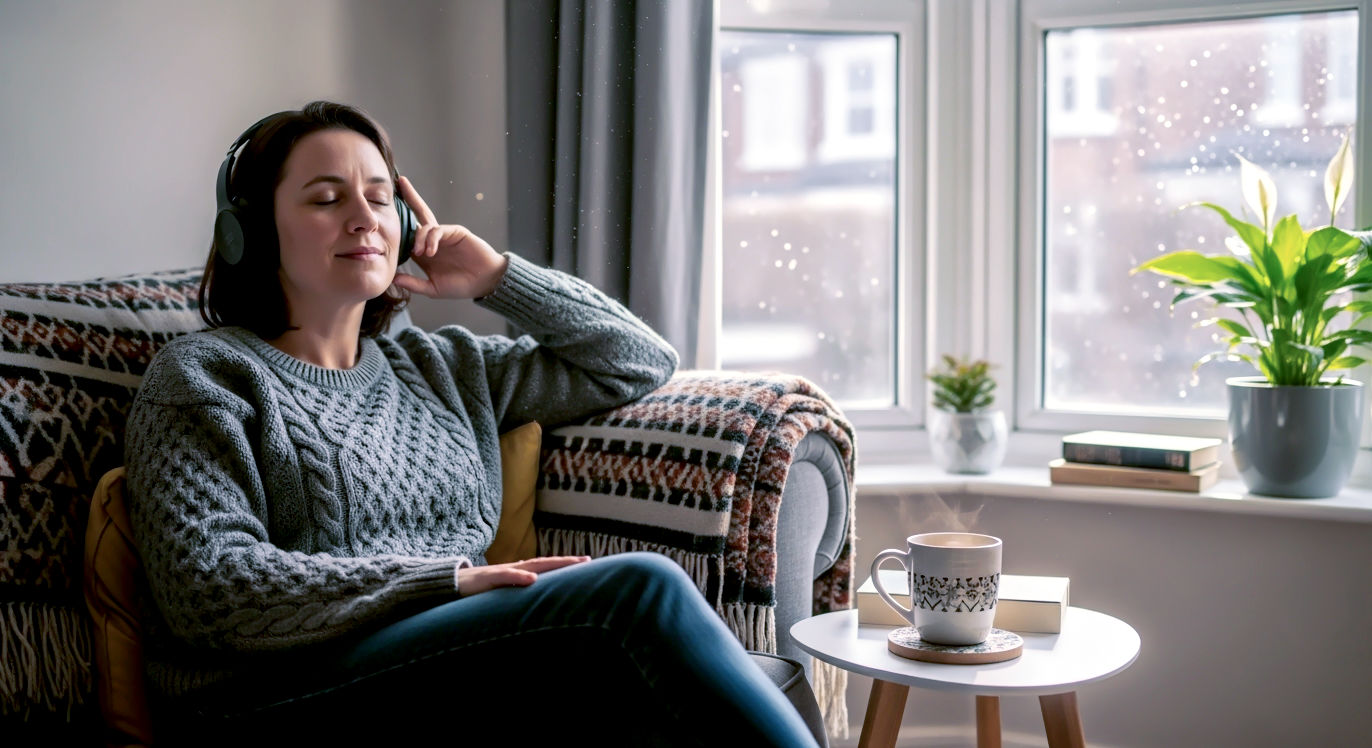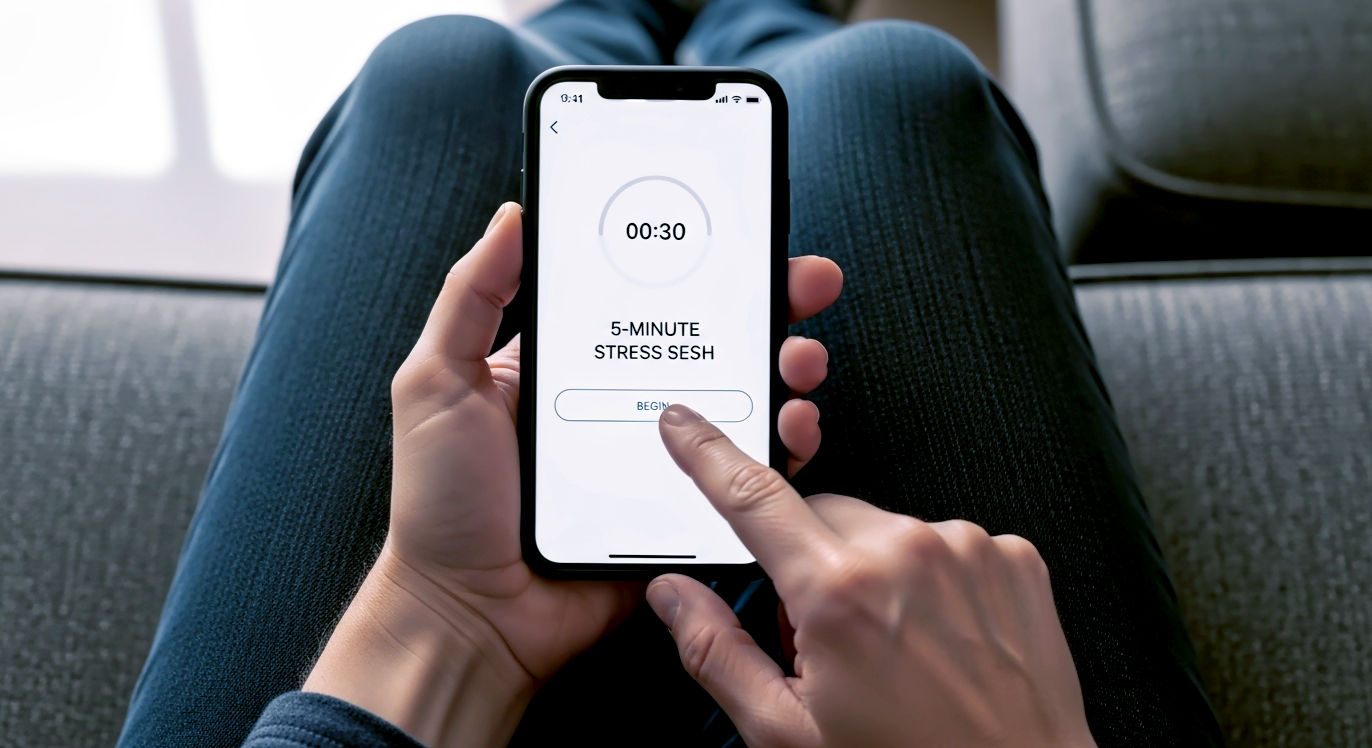Guided Meditation for Anxiety: The Definitive British Guide to Finding Calm
A simple, definitive guide for Brits on using guided meditation for anxiety. Learn how it works, how to start in 5 mins & where to find NHS & free resources.

This post may contain affiliate links. If you make a purchase through these links, we may earn a commission at no additional cost to you.
Let’s be honest, life in the UK can be stressful. You’re juggling work, the kids, the eye-watering cost of a loaf of bread, and the constant worry about whether you need a brolly. That background hum of stress can easily bubble over into full-blown anxiety.
It’s that tight, knotted feeling in your chest. The racing heart when you’re just trying to watch Gogglebox. The 3 a.m. brain-weasels who’ve decided it’s the perfect time to remind you of that daft thing you said in 2009.
If that sounds familiar, you’re not alone. At all.
In fact, anxiety is one of the most common mental health problems we face. Shocking new figures show that referrals for children and teens needing mental health support for anxiety have more than doubled since the pandemic. Hundreds of thousands of young people are on waiting lists for help.
When you feel that overwhelmed, you want something that works. Not crystals, not chanting, and not something that costs a fortune. You want a practical tool, like a spanner for your brain, that can help you dial down the panic.
That’s where guided meditation comes in.
This isn’t the “woo-woo” malarkey you might be thinking of. This is a practical, science-backed tool that even the NHS recommends. This guide is your no-nonsense look at how it works, why it works, and how you can get started in the next five minutes.
What Is This ‘Guided Meditation’ Thing, Anyway?
Before we get into the “how,” let’s clear up what we’re actually talking about.
So, What’s Anxiety, in Simple Terms?
Think of anxiety as your body’s built-in alarm system.
A thousand years ago, if a sabre-toothed tiger leapt out, your alarm would go off. Clang! Your body would flood with adrenaline, your heart would hammer, and your breathing would get fast. This is the “fight-or-flight” response. It’s brilliant for giving you the oomph to either leg it or punch a tiger.
The problem is, our modern brains can’t tell the difference between a tiger and a scary email from the boss.
That email, that packed Tube carriage, or even just a worry about money, can set off the same alarm. Anxiety is what happens when that alarm system gets stuck in the “on” position. Your body is constantly braced for a tiger that never, ever comes. It’s absolutely exhausting.
And What’s Guided Meditation?
Guided meditation is the simplest way to start meditation. That’s it.
Forget any image you have of a monk sitting perfectly still for six hours. This isn’t about that.
Guided meditation is simply having a friendly, calm voice (from an app, a YouTube video, or an NHS audio file) quietly talk you through a simple exercise.
The guide’s job is to help you gently focus your attention. They might ask you to notice your breathing, or to think about a calm place, or to just pay attention to parts of your body.
It’s perfect for beginners because you don’t have to do anything. You don’t have to “try” to be calm. You just have to pop in your earphones and listen.
The biggest myth about meditation is that you have to “empty your mind” or “stop thinking.” That’s impossible. You have a brain; its job is to think. Trying to stop it is like trying to stop your lungs from breathing.
Meditation isn’t about stopping thoughts. It’s about learning to watch them without getting dragged away by them.
Mindfulness vs. Guided Meditation: What’s the Difference?
You hear these two words all the time. It’s simple:
- Mindfulness is the goal. It’s the skill of paying attention to the present moment (what you can see, hear, feel right now) without judging it.
- Guided Meditation is the tool. It’s the 10-minute practice session where you train that skill, like lifting weights at the gym to build a muscle.
A guided meditation is your “how-to” lesson for becoming more mindful in your everyday life.
How Does Sitting Still Actually Stop Me Freaking Out? (The Science Bit)
This is the best part. This stuff isn’t magic; it’s biology. When you practise guided meditation, you are doing three powerful things to your body and brain.

1. It Flips Your Body’s “Calm Switch”
Remember that “fight-or-flight” alarm system? Well, your body has an “off” switch, too.
It’s called the parasympathetic nervous system, but let’s just call it the “rest-and-digest” system.
When this system is on, your body does the opposite of panicking. Your heart rate slows down. Your breathing gets deeper. Your muscles un-clench. Your body gets the message: “All clear. No tiger. Stand down.”
Guided meditation, especially the bits that focus on your breathing, is one of the fastest ways to manually flip that “calm switch.” You are telling your body, “It’s safe to relax now.”
2. It Rewires Your Brain (No, Really)
This is the bit that scientists get really excited about. Using brain scanners, they’ve found that regular meditation can physically change the shape of your brain.
Think of it like taking your brain to the gym:
- It shrinks your ‘fear centre’. There’s a little almond-shaped bit in your brain called the amygdala. This is your personal panic button. When you’re anxious, it’s overactive. Regular meditation has been shown to shrink it.
- It beefs up your ‘focus centre’. At the same time, it thickens the prefrontal cortex. This is the sensible, “adult-in-the-room” part of your brain responsible for focus, decision-making, and self-control.
You are literally training your brain to be less reactive and more thoughtful.
3. It Stops the “Worry Spiral”
Anxiety loves to feed on itself. You feel a bit anxious, so you start worrying about feeling anxious (“Oh no, what if this is a panic attack?”). This makes you more anxious, which makes you worry more… and on it goes.
Guided meditation breaks this loop.
It teaches you to take a step back and just notice your thoughts and feelings. The guide might say, “You might notice thoughts popping up. Just see them, like clouds floating by in the sky.”
When you can see a thought as just a “cloud” instead of a fact, it loses its power.
You can learn to see the thought “This is going to be a disaster” and just… let it float by. You don’t have to argue with it. You don’t have to believe it. You just notice it and bring your attention back to your breathing. This skill is a total game-changer.
Types of Guided Meditation: Find Your Flavour
“Meditation” isn’t one single thing. It’s a category, like “sport.” You might hate rugby but love swimming. Likewise, you might find one type of meditation tricky and another one a perfect fit.
Here are the most common types you’ll find in guided sessions for anxiety.
1. The Classic: Mindfulness of Breath
This is the bread-and-butter of meditation. It’s simple, it’s effective, and you can do it anywhere.
- What is it? The guide simply asks you to focus on the feeling of your breath. Where do you feel it most? The air at your nose? The rise and fall of your chest? Your belly?
- Why it works: Your breath is your “anchor” to the present moment. You can’t breathe in the future or in the past. When you are 100% focused on one breath in and one breath out, you are not worrying. It’s a safe, calm home base for your mind.
2. The Un-clencher: The Body Scan
This is brilliant if your anxiety makes you feel physically tense—all clenched jaws, hunched shoulders, and stomach knots.
- What is it? The guide leads you on a slow, gentle tour of your own body, usually from your toes all the way to the top of your head. They’ll say something like, “Bring your attention to your left foot… just notice any feelings there… now your ankle… your lower leg…”
- Why it works: You’re not told to relax the tension. You’re just asked to notice it. And a funny thing happens: the moment you shine a light of awareness on a clenched muscle, it often starts to let go all by itself. It’s incredibly relaxing and helps you get back in touch with your body.
3. The Be-Kind-to-Yourself One: Loving-Kindness Meditation
Anxiety often brings a friend: a really nasty inner critic. That voice that tells you you’re rubbish, you’re failing, you’re not good enough. Loving-Kindness meditation is the perfect antidote.
- What is it? The guide asks you to silently repeat a few simple, kind phrases. You usually start with yourself (e.g., “May I be happy. May I be safe. May I be peaceful.”). Then you send those same good wishes to people you love, and eventually, even to people you find tricky.
- Why it works: It feels a bit cheesy at first, but it’s a powerful way to build up your self-compassion. It trains your brain to be a friend to itself, not a bully.
4. The Escape Route: Visualisation (Guided Imagery)
Sometimes, your mind is just too frantic to focus on your breath. That’s when a bit of guided imagery is perfect.
- What is it? The guide uses descriptive words to help you build a detailed picture of a safe, calm place in your mind. This could be a warm, sunny beach, a quiet forest, or just a comfy, safe room. The NHS even has one called “Colour Breathing” where you imagine breathing in a calm colour.
- Why it works: It gives your anxious, spinning mind a positive, calming thing to focus on. It’s a bit like giving a hyperactive toddler a really good colouring book.
Your First 5-Minute Sesh: A Step-by-Step Guide
Right, let’s do this. No excuses. This will take less time than it takes to boil the kettle.

Step 1: Forget “Perfect.” You don’t need a special cushion, yoga pants, or a silent room. You can do this sitting on your office chair, on the bus, or hiding in the loo for five minutes.
Step 2: Get Comfy-ish. Sit in a chair with your feet on the floor and your back straight-ish but not stiff. Or lie down on your bed (though you might just fall asleep, which is also fine!). Gently close your eyes.
Step 3: Stick Some Earphones In. Grab your phone. Go to YouTube and search “5 minute guided meditation for anxiety.” Or open the NHS website and find their audio guides. Or download a free app like Insight Timer. Don’t spend ages picking one. Just pick one.
Step 4: Just Listen. Press play. Your only job for the next five minutes is to listen to the person’s voice. They will tell you exactly what to do.
Step 5: Your Mind Will Wander. 100%. This is the most important step. After about 10 seconds, your brain will go, “Right, bored now. What’s for tea? Did I lock the car? That bloke on the radio was an idiot.”
Step 6: The “Ah, Gotcha.” Moment. At some point, you’ll realise you’ve been thinking about your shopping list for the last two minutes. THIS IS THE MAGIC MOMENT. This is not failure. This is success. The moment you notice your mind has wandered is the moment you have just woken up. This is the “rep” in your brain workout.
Step 7: Gently Come Back. The instant you notice, just say a mental “Ah, well,” and gently bring your attention back to the guide’s voice. Don’t tell yourself off (“Ugh, I’m so bad at this!”). Just be kind. You’re a beginner.
Step 8: Repeat. A Lot. You will do this 10, 20, 50 times in five minutes. You’ll listen, you’ll drift off, you’ll notice, you’ll come back.
That’s it. That’s the entire practice. You have just meditated. Give yourself a pat on the back.
“Help! I’m Doing It Wrong!” (Common Worries, Sorted)
This is the part where most people give up, because their expectations are all wrong. Let’s sort out the most common worries.
“I can’t clear my mind! My brain is just too busy.”
Brilliant! You have a normal, working brain. You are not meant to “clear your mind.” That’s a myth. Your job is to notice the busy-ness. The aim isn’t an empty mind; it’s a focused mind. And the only way to train focus is to notice when you’ve lost it and bring it back. You’re not failing; you’re training.
“I fell asleep. Am I failing?”
Nope. You were knackered. Your body clearly needed sleep more than it needed meditation. It’s a sign that you finally relaxed! Take it as a win and try again when you’re a bit more awake.
“It’s so boring. I just feel fidgety and restless.”
Yes! That’s the anxiety! It hates being still. It wants you to be busy, distracted, and worrying. When you sit still, you’re basically poking the anxiety and saying, “I see you.” Your job is to just notice the fidgety feeling. Don’t fight it. Just get curious about it. “Ah, there’s that restless feeling in my legs. How interesting.”
“I tried it once, and I still feel anxious.”
You wouldn’t go to the gym once and then complain you don’t have a six-pack. This is brain training. It’s a skill. The benefits come from consistency, not from one perfect session. A grubby, distracted 5-minute practice every single day is a million times better than one “perfect” hour-long session.
“I actually felt more anxious!”
This is a really important one. It can happen. For your whole life, you’ve probably been running from your anxious feelings by keeping busy, scrolling on your phone, or working. When you sit still and turn off the distractions, you are finally left alone in a room with your anxiety. Of course, it feels loud! Be gentle. Try a shorter session (just one or two minutes). Try a ‘visualisation’ one instead of a ‘body scan’ one, as that can feel safer.
A Serious Word of Warning: For most people, meditation is incredibly safe. But if you have severe anxiety, complex PTSD, or a history of trauma, sitting still with your thoughts can sometimes be too much, too soon. It can even make things worse or trigger flashbacks.
This is not a replacement for professional help. If you’re struggling, please speak to your GP. They are your first and best port of call. They can refer you for talking therapies like CBT (Cognitive Behavioural Therapy) or even a special course called MBCT (Mindfulness-Based Cognitive Therapy), which is designed to help.
Think of guided meditation as a brilliant bit of health maintenance, like brushing your teeth. But if you have a massive cavity, you still need to see the dentist.
Making It Stick: Meditation for Real, Busy British Lives
Knowing how to do it is easy. Remembering to do it is the hard part.

1. Start Small. Stupidly Small.
Don’t aim for 20 minutes. You’ll fail. Aim for three minutes. Even one minute. There is no such thing as a “junk” meditation. One minute is better than zero minutes.
2. “Habit Stack” It.
Link your new meditation habit to something you already do every day.
- “I will meditate for 3 minutes after I brush my teeth.”
- “I will meditate for 5 minutes while the kettle boils for my first cuppa.”
- “I will meditate for 10 minutes as soon as I get into bed.” This makes it automatic.
3. Use It “In the Wild.”
You don’t just have to do this in a quiet room. The real power comes when you use it in the middle of a stressful day.
- On the Tube/Bus: Got your headphones? Stick on a 3-minute “breathing” meditation. No one will know. (The UK-made app Buddhify is brilliant for this, with meditations for “walking,” “travel,” and “work break.”)
- Before a Big Meeting: Go to the loo. Stand in the cubicle. Take three, slow, deep breaths. Focus only on your feet on the floor. You’ve just reset your nervous system.
- When You Can’t Sleep: This is a lifesaver. Instead of tossing and turning, put on a 20-minute ‘Body Scan’ or a ‘Sleep Story’ (the Calm app is famous for these). It gives your mind a job to do and eases you into rest.
Where to Find Good Guided Meditations (UK Edition)
You are spoilt for choice, and you don’t need to spend a penny.
The Big Apps (The “Netflix” of Meditation)
- Calm and Headspace: These are the two most famous. They are brilliant, slick, easy to use, and have hundreds of sessions. They both have free trials, but you have to pay a subscription after that (around £30-£50 a year).
- Insight Timer: This is a massive library of meditations. The brilliant thing is that thousands of them are completely free. It can be a bit overwhelming, but if you filter by “Anxiety” and “5 minutes,” you’ll find gold.
- Buddhify: A fantastic UK-based app. It’s not free (costs a few quid upfront), but it has no subscription. Its real strength is sorting meditations by what you’re doing (e.g., “On your phone,” “Can’t sleep,” “Walking”).
Top Free Resources (No Quid Needed)
- The NHS Website: Yes, the NHS! They have a section on their website called “Mindfulness” with free audio guides to stream or download. They are simple, no-frills, and backed by clinical advice.
- Mind (The Mental Health Charity): The Mind website is a goldmine of trustworthy information on mindfulness for anxiety. They explain it clearly and have links to other great resources.
- The Free Mindfulness Project: Just what it says on the tin. A website dedicated to giving away free mindfulness MP3s. No catch.
- YouTube: Obvious, but true. There are thousands of amazing, high-quality guided meditations for free. The key is to find a voice you like. Search “5 minute guided meditation for anxiety” and try a few.
Your Next Steps: From Anxious to Anchored
So, there you have it.
Guided meditation isn’t a magic wand. It won’t make your annoying colleague disappear or pay your gas bill.
But it is a tool. A powerful, proven, and practical tool that gives you a bit of control back. It gives you a sliver of space between you and your panic. It teaches you that your thoughts are just thoughts, not commands.
It’s a way of training your brain to be less of a frantic mess and more of a steady friend.
You don’t need to become a “meditation person.” You just need to be a person who wants to feel a bit less anxious and is willing to try something new for five minutes.
You’ve got nothing to lose but that horrible, jittery, knotted-up feeling. So go on. Find a 5-minute guide, pop your headphones in, and just see what happens. You might be chuffed you did.
Further Reading & Help
For more information and professional support, these UK-based resources are an excellent place to start.
- NHS: Mindfulness: The official NHS page explaining mindfulness and linking to free audio guides for stress, anxiety, and depression.
- Mind (The Mental Health Charity): Expert, easy-to-read information on mindfulness for mental wellbeing, including tips and guidance on finding a course.
- Mental Health Foundation: In-depth guides on mindfulness, how it helps, and how to practise.
- The Free Mindfulness Project: A collection of free-to-download guided meditation exercises.
- Samaritans: If you’re having a really tough time and need to talk to someone, they are available 24/7. Call: 116 123 (free from any phone)



